Spatial Pattern Reconstruction of Water and Land Resources in Coal Mining Subsidence Areas within Urban Regions
Abstract
:1. Introduction
2. Spatial Pattern Reconstruction Method of Water and Land Resources in Unstable Coal Mining Subsidence Area within Urban Regions
2.1. A Brief Description of the Spatial Pattern Reconstruction Method
- (1)
- Data on the geological and mining conditions of the subsidence areas are initially collected, including their strata composition, geological structure, hydrogeological data and coal mining data. The final subsidence values are then predicted based on the collected data, the probability integration method and the subsidence prediction parameters. The subsidence values, groundwater level elevation and precipitation are combined to analyze the distribution of subsidence waterlogging. Afterwards, the subsidence areas within urban regions are divided into waterlogging and non-waterlogging areas.
- (2)
- The scope of subsidence waterlogging and the underwater bottom topography of the waterlogging area are predicted. This area will be renovated into a landscape lake district in the city by a series of transformation measures, including deep-excavation and shallow-filling governance, slope revetment reconstruction and ecological environment management.
- (3)
- The stability of the overlying strata in the goaf of the non-waterlogging area is analyzed based on the structure and damage of the overlying strata above the goaf. The ground areas above the goaf are divided into stable and unstable areas. The unstable area is transformed into an urban green space, whereas the stable area is further analyzed as a construction area.
- (4)
- The surface residual subsidence values at the stable area above the goaf are predicted. If the surface subsidence is large and exceeds the subsidence limit, then this area will be designated as the prohibited building area or restricted construction area until the surface subsidence becomes stabilized after a few years. The remaining area within the subsidence limit needs to be further evaluated for the foundation stability of the construction buildings so as to determine the allowable height of buildings. The sum of the height of the fracture zone and caving zone and the influence depth of the building load are then calculated. If the calculated value is less than the coal mining depth, then the building height has no restriction. Otherwise, the design height of the building is reduced until the foundation stability requirements of the construction buildings are met. This area will also be designated as the restricted construction area. If the foundation stability requirements cannot be met, then this area will be designated as the prohibited building area.
- (5)
- According to the foundation stability of the surface buildings, the land resources of the non-waterlogging area are divided into unaffected, restricted and prohibited building areas, which are transformed differently as follows:
- The unaffected building areas are reasonably planned as the residential and commercial areas to solve the contradiction between the expansion of the subsidence area and the rapid growth of residential land resources for construction and to improve the value of land use.
- Although the buildings in the restricted construction area are affected by mining subsidence, the impact is relatively small, and residential areas and large shopping malls with low floors can be built.
- The prohibited building area can be designed as part of a wetland park to maintain and improve the surrounding ecological environment. In this area, urban green spaces can be built, and sports and entertainment facilities can be constructed to provide recreational places for the surrounding residents.
2.2. Reconstruction of Water and Land Resources in the Waterlogging Area
2.2.1. Surface Subsidence Prediction
2.2.2. Waterlogging Area Prediction
2.2.3. Terrain Modification and Reconstruction of the Subsidence Waterlogging Area
2.3. Reconstruction of Land Resources in the Non-Waterlogging Area
2.3.1. Activation Analysis of the Rock Mass in Goaf
2.3.2. The Surface Residual Subsidence Prediction
2.3.3. The Influence Depth Calculation of Ground Building Load
2.3.4. The Height Calculation of Collapsed Zone and Cracked Zone
2.3.5. The Height Calculation of Buildings
3. Case Study
3.1. Overview of the Study Area
3.2. The Waterlogging Area Prediction
3.3. The Residual Subsidence Prediction
3.4. The Building Feasibility Analysis of the Study Area
3.4.1. The Height Calculation of Collapsed Zone and Cracked Zone
3.4.2. The Allowable Height Calculation of Buildings
3.5. Spatial Pattern Reconstruction of Water and Land Resources in the Study Area
- (1)
- Unaffected building area is the yellow area in Figure 15. The surface deformation and the disturbing depth of the building foundation are within the safe value in this area. New buildings affected by the residual deformation are small. According to construction needs, residential houses and large shopping malls can be built in this area to solve the contradiction between the expansion of the subsidence area and the rapid growth of residential land. For several central islands in the lake, considering the complexity of the foundation and the rationality of the landscape ecology, the islands should be planned as wildlife habitats, which increases the ecological value of Lv Jin Lake Central Park. The island that the road crosses is located in the central area and can build low-level floor public health facilities.
- (2)
- Building area affected by residual subsidence is the orange area in Figure 15. The building in this area is affected by residual subsidence. The damage value is less than the Grade I building damage level. The building will not be damaged theoretically. When calculating the additional stress, the number of building floors has no limit. Therefore, although the building in this area is affected by mining, the impact is relatively small, and residential houses and large shopping malls can be built.
- (3)
- Restricted building area is the red area in Figure 15, mainly distributed in the northeast of the treatment area. It is mainly affected by the height of the collapsed zone and cracked zone in the III 426 working face of the fourth coal seam. Therefore, building structures with more than 25 floors in the nearby area is not advisable. Hotels and resorts can be built in this area, to serve the tourism industry in the Lv Jin Lake.
- (4)
- Green land is the green area in Figure 15. A small part of the building area is planned as a greening area to reduce soil erosion in the boundary area of deep-excavation and shallow-filling. The surface has deformations, but the surface movement and deformation are small, and the surface fluctuation does not change significantly.
- (5)
- Water area is the blue area in Figure 15. It is a combination of the waterlogging area and the terrain change caused by the implementation of deep-excavation and shallow-filling projects in the coal mining subsidence. The area is planned as a water area and an important part of the plan. Given the impact of coal mining subsidence in the early stage, a large waterlogging area is formed in the Lv Jin Lake research area, which is planned as part of the water area. On the one hand, to increase the integrity of the lake, water bodies with large areas and abundant biomass and plants and their landscape environment are restored, and a new tourism route is built, which integrates sightseeing and ecological leisure. On the other hand, large areas of water are utilized to develop cage culture. This method has higher requirements on the water body. If feasible, it can significantly alleviate the tension of farmland loss caused by subsidence.
4. Discussion
4.1. Economic Benefits
4.2. Ecological Benefits
4.3. Social Benefits
4.4. Comparison Analysis
5. Conclusions
- (1)
- This study introduces a set of scientific and complete methods for reconstructing the spatial pattern of water and land resources in unstable coal mining subsidence areas within urban areas. The shortage of land resources in coal mining subsidence areas is addressed, the stability of the coal mining subsidence area is analyzed, the unstable subsidence area is reasonably planned and utilized and an ecologically livable green urban area is built to achieve a sustainable development of coal-resource-based cities.
- (2)
- The Lv Jin Lake in Huaibei is selected as a case study, on the basis of surface subsidence and groundwater level; the coal mining subsidence is divided into waterlogging and non-waterlogging areas. Terrain modification and reconstruction are carried out in the waterlogging area by using the deep-excavation and shallow-filling method and by reconstructing the slope. New buildings are constructed in the non-waterlogging area. The allowable height of buildings on the ground is calculated by analyzing the superposition of surface residual subsidence, the height of the collapsed zone and cracked zone and the additional stress of surface buildings. The fourth coal seam III426 working face has the minimum mining depth, and the allowable building height above is not more than 25 floors. The height of buildings in other areas theoretically has no limit.
- (3)
- Scientific and rational planning ensures that the abundant water and land resources are fully utilized. Residential houses and large shopping malls are built in the unaffected building area, and the building area is influenced by residual subsidence. Buildings with no more than 25 floors, hotels and resorts are built in the restricted building area. The green land can reduce soil erosion, and the large area of water increases the integrity of the study area. Abundant biomass and plants are restored, and cage culture is developed.
- (4)
- In the case study, a coal-resource-based city is transformed into a sustainable development city with huge economic, ecologic and social benefits. In this area, the water and land resources utilization rate reaches 100%, and the direct revenues exceed 30 billion yuan. A habitat for plants and animals is provided, and the available ecosystem services have huge potential. The shortage of urban construction land is alleviated, more than 2 × 105 people have been successfully resettled and employment opportunities are abundant. The human–land conflict in mining areas is eased, and a coordinated development of society, economy and nature is promoted. The work presented in this paper may serve as a reference for similar mining subsidence area treatment projects in the future.
Author Contributions
Funding
Institutional Review Board Statement
Informed Consent Statement
Data Availability Statement
Acknowledgments
Conflicts of Interest
References
- Huang, J.; Tian, C.Y.; Xing, L.F.; Bian, Z.F.; Miao, X.X. Green and sustainable mining: Underground coal mine fully mechanized solid dense stowing-mining method. Sustainability 2017, 9, 1418. [Google Scholar] [CrossRef]
- Qian, D.Y.; Zhang, N.; Pan, D.J.; Xie, Z.Z.; Shimada, H.; Wang, Y.; Zhang, C.H.; Zhang, N.C. Stability of deep underground openings through large fault zones in argillaceous rock. Sustainability 2017, 9, 2153. [Google Scholar] [CrossRef]
- Zhang, M.W.; Shimada, H.; Sasaoka, T.; Matsui, K.; Dou, L.M. Evolution and effect of the stress concentration and rock failure in the deep multi-seam coal mining. Environ. Earth Sci. 2014, 72, 629–643. [Google Scholar] [CrossRef]
- Bai, E.H.; Guo, W.B.; Zhang, H.B.; Tan, Y.; Guo, M.J. In situ groundwater protection technology based on mining-conservation coordination in the middle and upper reaches of Yellow River Basin. J. China Coal Soc. 2021, 46, 907–914. [Google Scholar]
- Zhu, X.J.; Zha, F.; Guo, G.L.; Zhang, P.F.; Cheng, H.; Liu, H.; Yang, X.Y. Subsidence control design method and application to backfill-strip mining technology. Adv. Civ. Eng. 2021, 2021, 5177174. [Google Scholar] [CrossRef]
- Jiang, N.; Wang, C.X.; Pan, H.Y.; Yin, D.W.; Ma, J.B. Modeling study on the influence of the strip filling mining sequence on mining-induced failure. Energy Sci. Eng. 2020, 8, 2239–2255. [Google Scholar] [CrossRef]
- Marschalko, M.; Yilmaz, I.; Křístková, V.; Fuka, M.; Kubečka, K.; Bouchal, T.; Bednarik, M. Optimization of building site category determination in an undermined area prior to and after exhausting coal seams. Int. J. Rock Mech. Min. Sci. 2012, 54, 9–18. [Google Scholar] [CrossRef]
- Wang, C.L.; Zhang, C.S.; Zhao, X.D.; Liao, L.; Zhang, S.L. Dynamic structural evolution of overlying strata during shallow coal seam longwall mining. Int. J. Rock Mech. Min. Sci. 2018, 103, 20–32. [Google Scholar] [CrossRef]
- He, M.C.; Wang, Q.; Wu, Q.Y. Innovation and future of mining rock mechanics. J. Rock Mech. Geotech. Eng. 2021, 13, 1–21. [Google Scholar] [CrossRef]
- Xie, Z.Z.; Zhang, N.; Yuan, Y.X.; Xu, G.; Wei, Q. Study on safety control of composite roof in deep roadway based on energy balance theory. Sustainability 2019, 11, 3688. [Google Scholar] [CrossRef]
- Wang, F.; Jiang, B.Y.; Chen, S.J.; Ren, M.Z. Surface collapse control under thick unconsolidated layers by backfilling strip mining in coal mines. Int. J. Rock Mech. Min. Sci. 2019, 113, 268–277. [Google Scholar] [CrossRef]
- Zhang, Y.; Cao, S.G.; Zhang, N.; Zhao, C.Z. The application of short-wall block backfill mining to preserve surface water resources in northwest China. J. Clean. Prod. 2020, 261, 121232. [Google Scholar] [CrossRef]
- Huang, Y.L.; Li, J.M.; Ma, D.; Gao, H.D.; Guo, Y.C.; Ouyang, S.Y. Triaxial compression behaviour of gangue solid wastes under effects of particle size and confining pressure. Sci. Total Environ. 2019, 693, 133607. [Google Scholar] [CrossRef] [PubMed]
- Nie, L.; Wang, H.; Xu, Y.; Li, Z. A new prediction model for mining subsidence deformation: The arc tangent function model. Nat. Hazards 2014, 75, 2185–2198. [Google Scholar] [CrossRef]
- Hu, Z.Q.; Duo, L.H.; Shao, F. Optimal Thickness of Soil Cover for Reclaiming Subsided Land with Yellow River Sediments. Sustainability 2018, 10, 3853. [Google Scholar] [CrossRef]
- Liu, H.; Zhang, M.; Su, L.J.; Chen, X.X.; Liu, C.F.; Sun, A.G. A boundary model of terrain reconstruction in a coal-mining subsidence waterlogged area. Environ. Earth Sci. 2021, 80, 187. [Google Scholar] [CrossRef]
- Hu, B.N.; Guo, W.Y. Mining subsidence area status, syntheses governance model and governance recommendation. Coal Min. Technol. 2018, 23, 1–4. [Google Scholar]
- Zhao, J.H.; Jiang, N.; Yin, L.M.; Bai, L.Y. The effects of mining subsidence and drainage improvements on a waterlogged area. Bull. Eng. Geol. Environ. 2018, 78, 3815–3831. [Google Scholar]
- Faunt, C.C.; Sneed, M.; Traum, J.; Brandt, J.T. Water availability and land subsidence in the Central Valley, California, USA. Hydrogeol. J. 2015, 24, 675–684. [Google Scholar] [CrossRef]
- Wu, Q.Y.; Pang, J.W.; Qi, S.Z.; Li, Y.P.; Han, C.C.; Liu, T.X.; Huang, L.M. Impacts of coal mining subsidence on the surface landscape in Longkou city, Shandong Province of China. Environ. Earth Sci. 2009, 59, 783–791. [Google Scholar]
- Shang, Y.Z.; Lu, S.B.; Li, X.F.; Hei, P.F.; Lei, X.H.; Gong, J.G.; Liu, J.H.; Zhai, J.Q.; Wang, H. Balancing development of major coal bases with available water resources in China through 2020. Appl. Energy 2017, 194, 735–750. [Google Scholar] [CrossRef]
- Liu, H.; Zhu, X.J.; Cheng, H.; Su, L.J.; Dai, L.J.; Zheng, L.G.; Fang, S.Z.; Jiang, C.L.; Zhang, Q.; Sun, Q.Y.; et al. Key technology of human environment and ecological reconstruction in high submersible level coal mining subsidence area: A case study from Lüjin Lake, Huaibei. J. China Coal Soc. 2021, 46, 4021–4032. [Google Scholar]
- Singh, S.K.; Pandey, A.C. Geomorphology and the controls of geohydrology on waterlogging in Gangetic Plains, North Bihar, India. Environ. Earth Sci. 2013, 71, 1561–1579. [Google Scholar] [CrossRef]
- Blanchette, M.L.; Lund, M.A. Pit lakes are a global legacy of mining: An integrated approach to achieving sustainable ecosystems and value for communities. Curr. Opin. Environ. Sustain. 2016, 23, 28–34. [Google Scholar] [CrossRef]
- Pérez-Sindín, X.; Blanchette, M.L. Correction to: Understanding public perceptions of a new Pit Lake in as pontes, Spain. Mine Water Environ. 2020, 39, 657. [Google Scholar] [CrossRef]
- Dhakate, R.; Modi, D.; Rao, V.V.S.G. Impact assessment of coal mining on river water and groundwater and its interaction through hydrological, isotopic characteristics, and simulation flow modeling. Arab. J. Geosci. 2018, 12, 8. [Google Scholar] [CrossRef]
- Zhu, X.J.; Ning, Z.Y.; Cheng, H.; Zhang, P.F.; Sun, R.; Yang, X.Y.; Liu, H. A novel calculation method of subsidence waterlogging spatial information based on remote sensing techniques and surface subsidence prediction. J. Clean. Prod. 2022, 335, 130366. [Google Scholar] [CrossRef]
- Hu, Z.Q.; Xiao, W.; Zhao, Y.L. Re-discussion on coal mine eco-environment concurrent mining and reclamation. J. China Coal Soc. 2020, 45, 351–359. [Google Scholar]
- Li, F.M. Discussion on several technical problems in comprehensive treatment of surface ground subsidence caused by coal mining operation. Coal Sci. Technol. 2003, 33, 59–60. [Google Scholar]
- Tan, X.H.; Peng, Y.L.; Liu, S.L.; Liu, P. Landscape pattern and ecotourism carrying capacity of Pan’an Lake wetland park in Xuzhou City, China. Desalination Water Treat. 2020, 188, 288–296. [Google Scholar] [CrossRef]
- Xu, J.X.; Yin, P.C.; Hu, W.M.; Fu, L.L.; Zhao, H. Assessing the ecological regime and spatial spillover effects of a reclaimed mining subsided lake: A case study of the Pan’an Lake wetland in Xuzhou. PLoS ONE 2020, 15, e0238243. [Google Scholar] [CrossRef] [PubMed]
- Hu, Z.Q. The 30 years’ land reclamation and ecological restoration in China: Review, rethinking and prospect. Coal Sci. Technol. 2019, 47, 25–36. [Google Scholar] [CrossRef]
- Hu, Z.Q.; Xiao, W. Optimization of concurrent mining and reclamation plans for single coal seam: A case study in northern Anhui, China. Environ. Earth Sci. 2012, 68, 1247–1254. [Google Scholar] [CrossRef]
- Chugh, Y.P. Concurrent mining and reclamation for underground coal mining subsidence impacts in China. In Proceedings of the 2nd International Symposium on Land Reclamation and Ecological Restoration (LRER), Xian, China, 20–23 October 2017; pp. 315–332. [Google Scholar]
- Hu, Z.; Xiao, W.; Fu, Y. Innovations of concurrent mining and reclamation for underground coal mines in China. In Proceedings of the 16th International Symposium on Environmental Issues and Waste Management in Energy and Mineral Production (SWEMP)/International Symposium on Computer Applications (CAMI), Istanbul, Turkey, 5–7 October 2016. [Google Scholar]
- Guan, J.; Yu, P. Does coal mining have effects on land use changes in a coal resource-based city? Evidence from Huaibei City on the North China Plain. Int. J. Environ. Res. Public Health 2021, 18, 11616. [Google Scholar] [CrossRef] [PubMed]
- Li, G.S.; Hu, Z.Q.; Li, P.Y.; Yuan, D.Z.; Wang, W.J.; Han, J.Z.; Yang, K. Optimal layout of underground coal mining with ground development or protection: A case study of Jining, China. Res. Policy 2022, 76, 102639. [Google Scholar] [CrossRef]
- Wu, J.; Bai, Z.K. Spatial and temporal changes of the ecological footprint of China’s resource-based cities in the process of urbanization. Res. Policy 2022, 75, 102491. [Google Scholar] [CrossRef]
- He, Y.; Lin, Y.; Zhou, G.; Zhu, Y.; Tang, K. Spatial pattern and drivers of urbanization in China’s mid-level developing urban agglomeration: A case study of Chang-Zhu-Tan. Reg. Sustain. 2021, 2, 83–97. [Google Scholar] [CrossRef]
- Ge, X.J.; Liu, X.X. Urban land use efficiency under resource-based economic transformation—A case study of Shanxi Province. Land 2021, 10, 850. [Google Scholar] [CrossRef]
- Wu, Z.H.; Lei, S.G.; Yan, Q.W.; Bian, Z.F.; Lu, Q.Q. Landscape ecological network construction controlling surface coal mining effect on landscape ecology: A case study of a mining city in semi-arid steppe. Ecol. Indic. 2021, 133, 108403. [Google Scholar] [CrossRef]
- Yang, D.W.; Gao, X.L.; Xu, L.X.; Guo, Q.H. Constraint-adaptation challenges and resilience transitions of the industry–environmental system in a resource-dependent city. Res. Conserv. Recycl. 2018, 134, 196–205. [Google Scholar] [CrossRef]
- Xiang, Z.; Liu, X.Y. Coal-based transformation of cities in Shandong Province, China. Chin. J. Popul. Res. Environ. 2015, 13, 358–364. [Google Scholar] [CrossRef]
- Lin, C.C.; Zheng, L.G.; Wei, X.P.; Dong, X.L.; Chen, X. Study on landscape pattern changes before and after the governance in zhonghu coal mining subsidence area in Huaibei. Adm. Tech. Environ. Monit. 2021, 33, 14–19. [Google Scholar]
- Liu, Y.; Zhu, J.R.; Gao, W.H.; Guo, Z.H.; Xue, C.; Pang, J.Y.; Shu, L.Z. Effects of biochar amendment on bacterial and fungal communities in the reclaimed soil from a mining subsidence area. Environ. Sci. Pollut. Res. Int. 2019, 26, 34368–34376. [Google Scholar] [CrossRef]
- Litwiniszyn, J. Application of the equation of stochastic processes to mechanics of loose bodies. Arch. Mech. Stos. 1956, 8, 393–411. [Google Scholar]
- Liu, B.C. Stochastic medium theory and its application in surface subsidence caused by excavation. Chin. J. Nonferrous Met. 1992, 2, 8–14. [Google Scholar]
- China Coal Research Institute. Buildings, water bodies, railways and main shafts and coal pillars and coal mining regulations. China Coal Ind. Press 2017, in press. [Google Scholar]
- Hu, Q.F.; Deng, X.B.; Feng, R.M.; Li, C.Y.; Wang, X.J.; Jiang, T. Model for calculating the parameter of the Knothe time function based on angle of full subsidence. Int. J. Rock Mech. Min. Sci. 2015, 78, 19–26. [Google Scholar] [CrossRef]
- Cui, X.M.; Wang, J.C.; Liu, Y.S. Prediction of progressive surface subsidence above longwall coal mining using a time function. Int. J. Rock Mech. Min. Sci. 2001, 38, 1057–1063. [Google Scholar] [CrossRef]
- Zhu, X.J.; Guo, G.L.; Zha, J.F.; Chen, T.; Fang, Q.; Yang, X.Y. Surface dynamic subsidence prediction model of solid backfill mining. Environ. Earth Sci. 2016, 75, 1007. [Google Scholar] [CrossRef]
- Bian, Z.F.; Zhang, G.L. Principle of dredging and draining method of subsided land reclamation for coal mining and its application. J. China Univ. Min. Technol. 1996, 25, 84–88. [Google Scholar]
- Bernadette, U.U.; Ogbonnaya, L.; Oyem, E.U. Modeling and characterization of mine pit backflling/reclamation materials around Gyel’A’ and Kantoma areas of Plateau state using integrated method. Modeling Earth Syst. Environ. 2021, 2022, 3385–3398. [Google Scholar]
- Pan, H.Y.; Cheng, A.G. Comparative study on comprehensive control policies for mining subsidence at home and abroad. Energy Technol. Manag. 2020, 45, 25–28 + 32. [Google Scholar]
- Li, Q.T.; Peng, T.; Yang, J.; He, J.Q.; Wang, J.W. Investigate ecological restoration project of abandoned mines in Beijing-Tianjin-Hebei area. World Nonferrous Met. 2020, 6, 259–260. [Google Scholar]
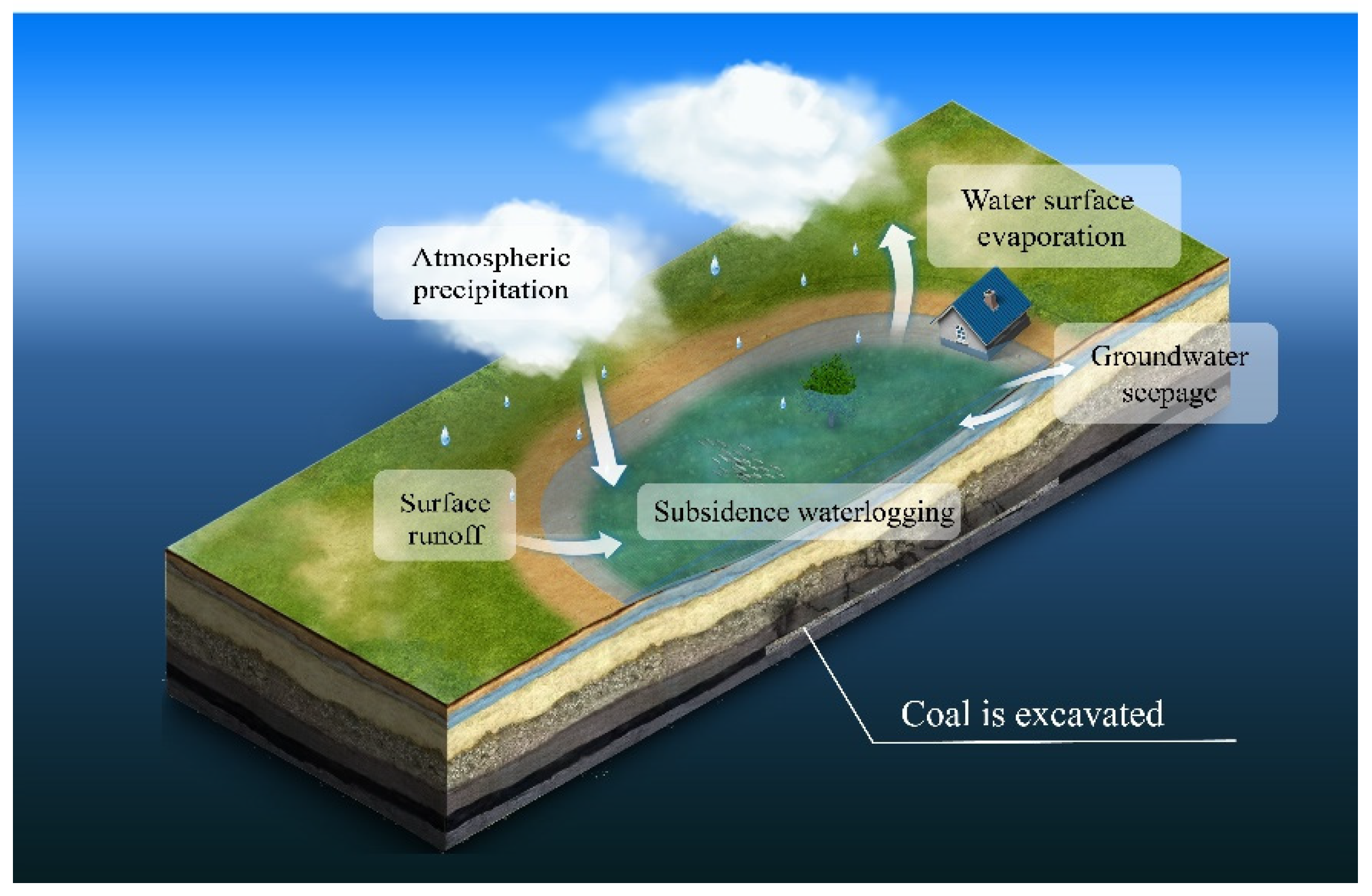
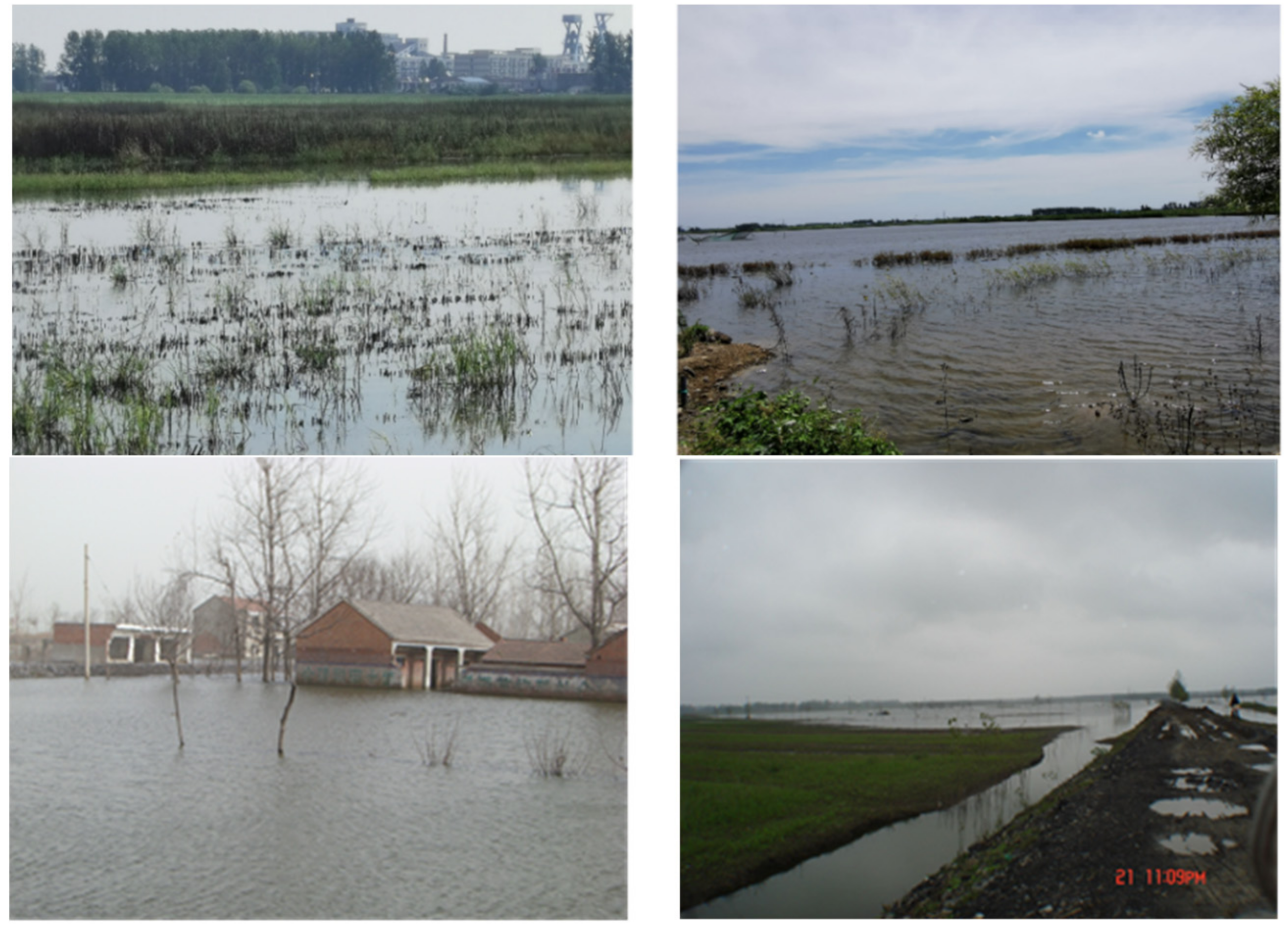
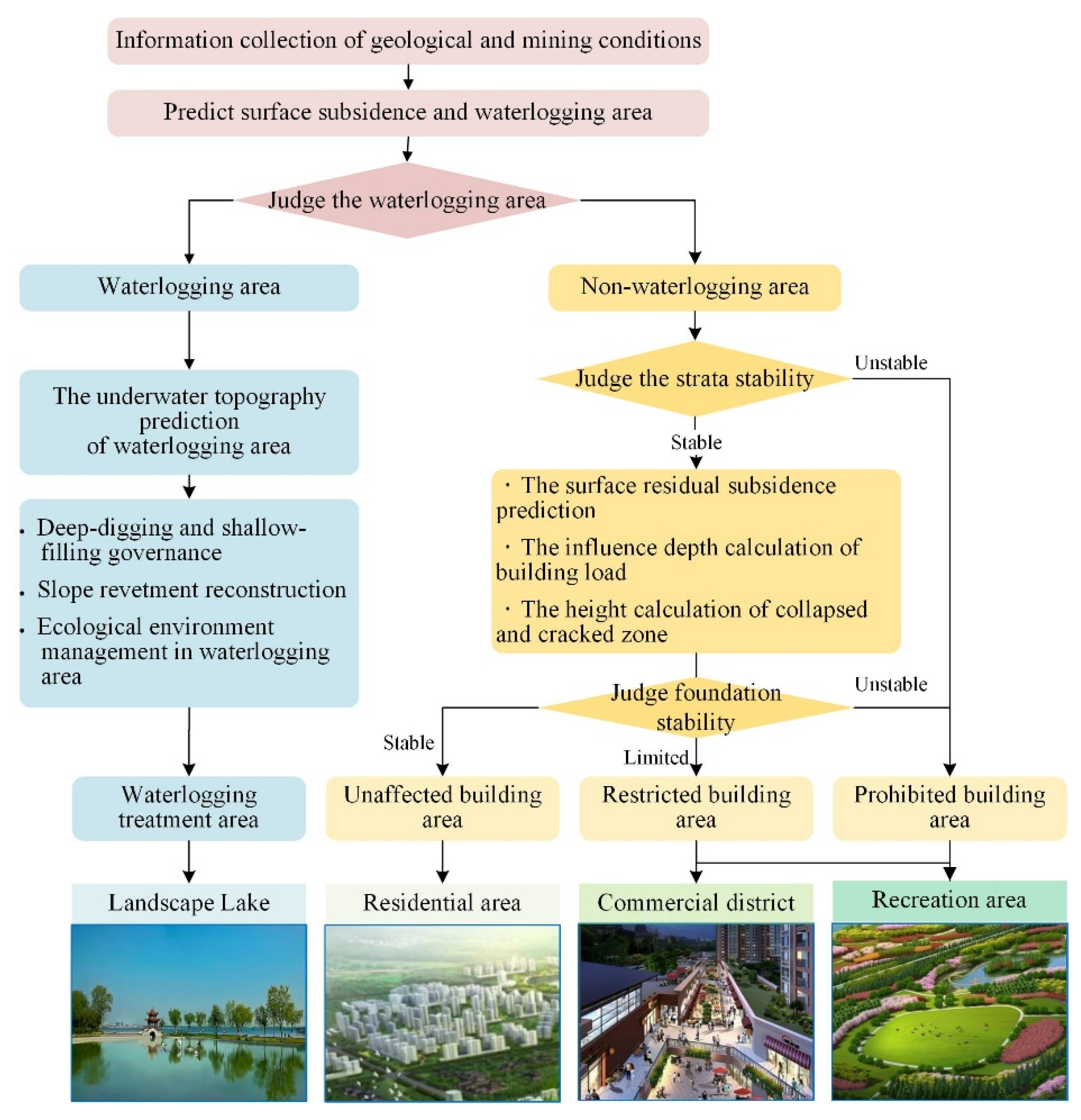
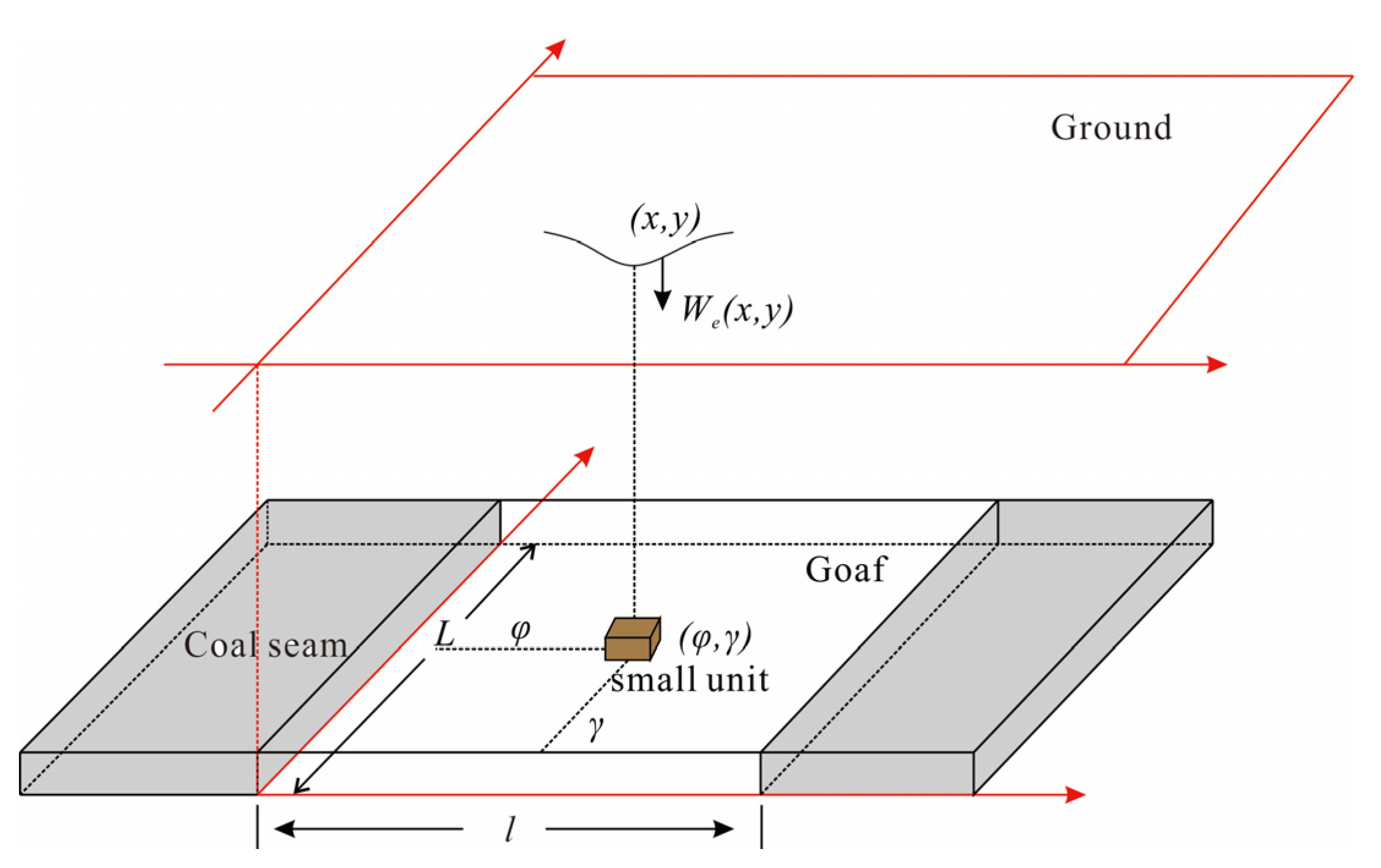
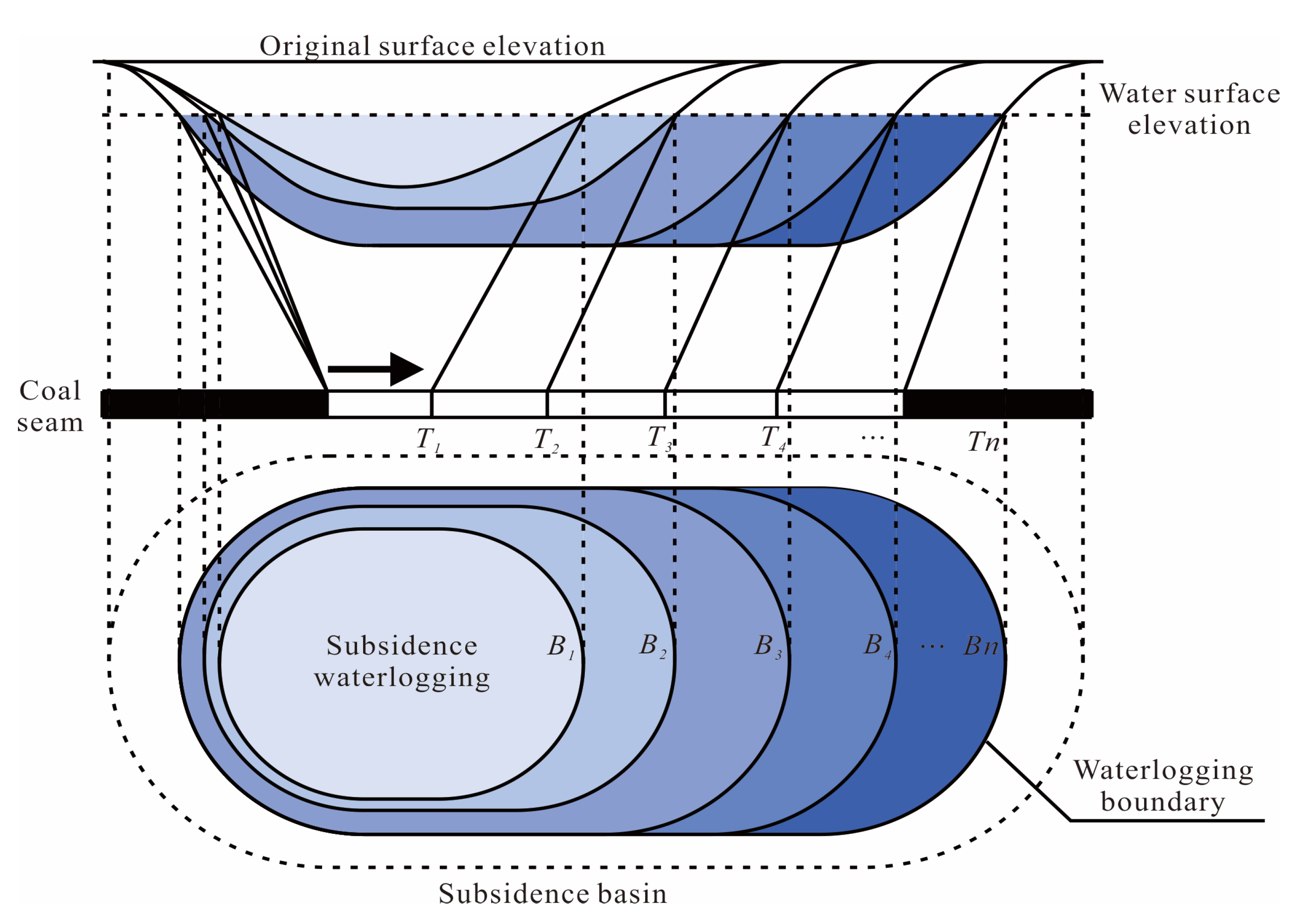
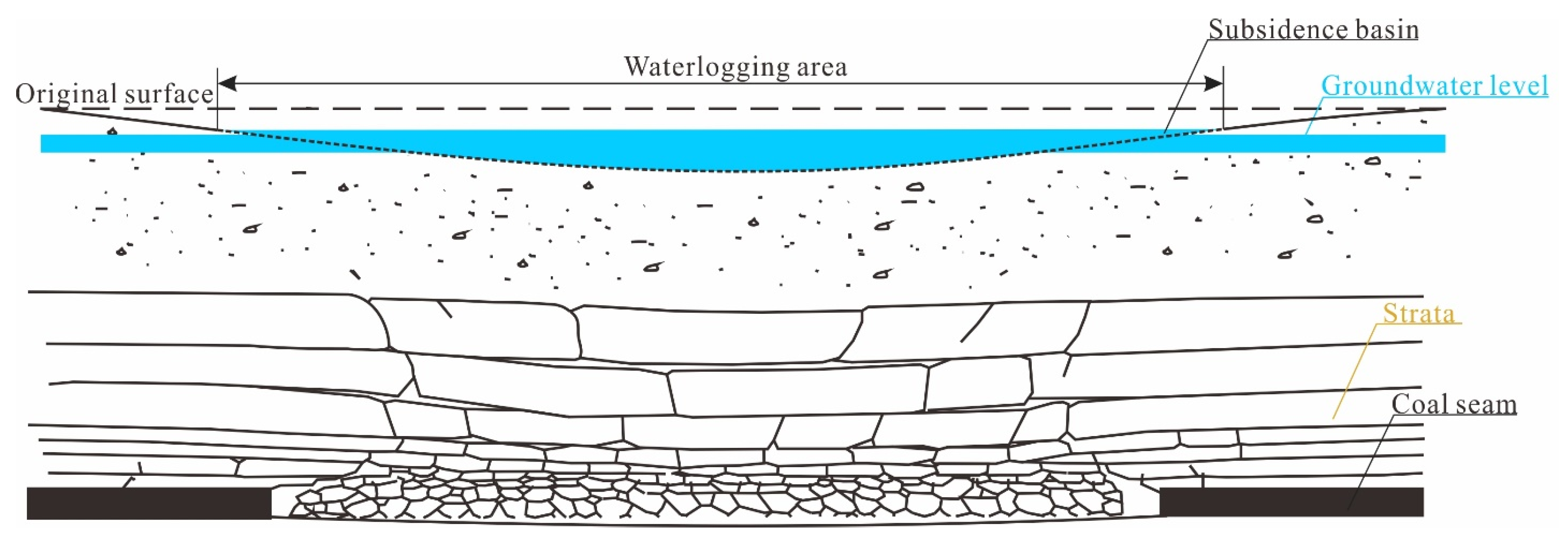
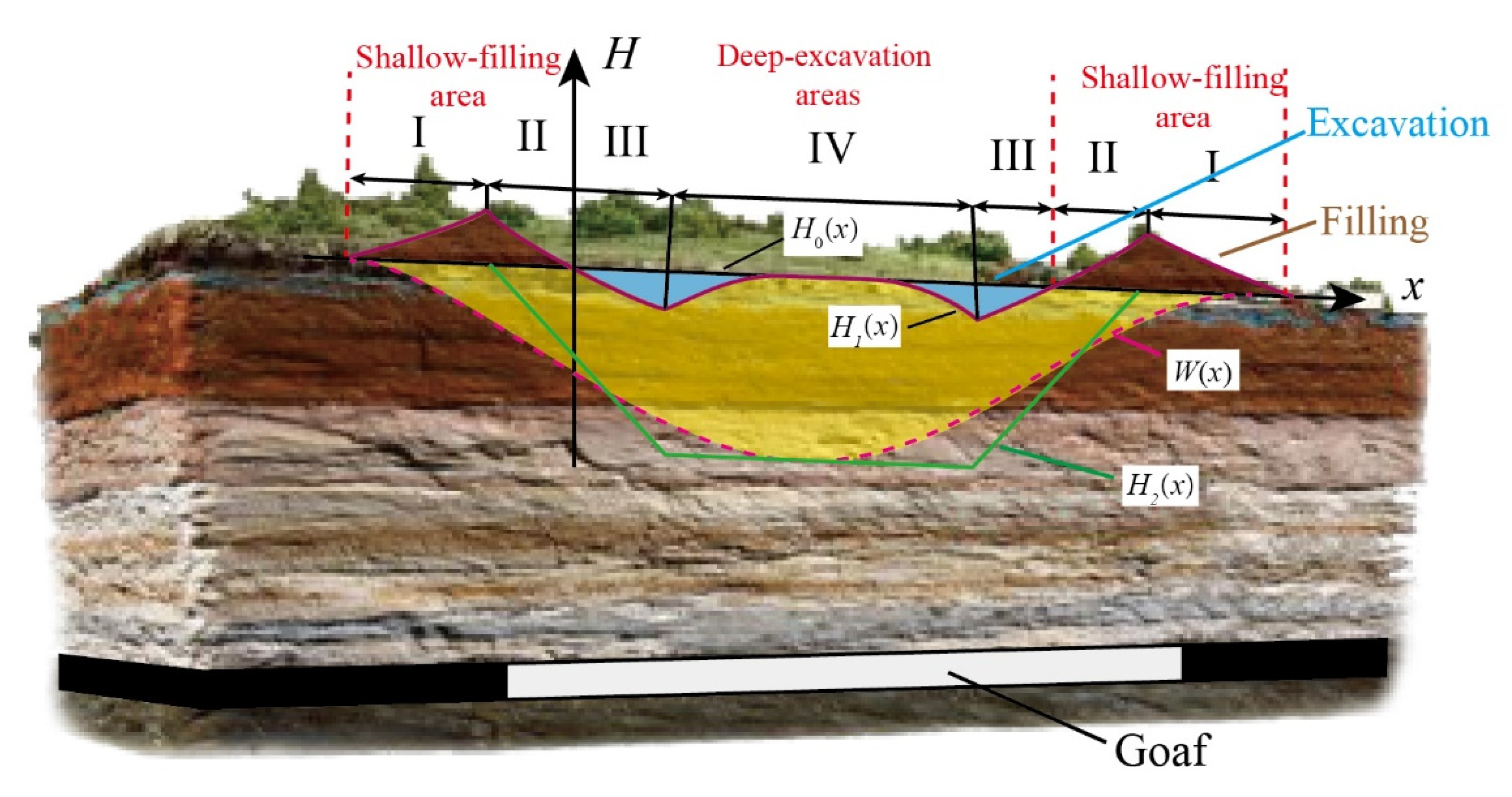
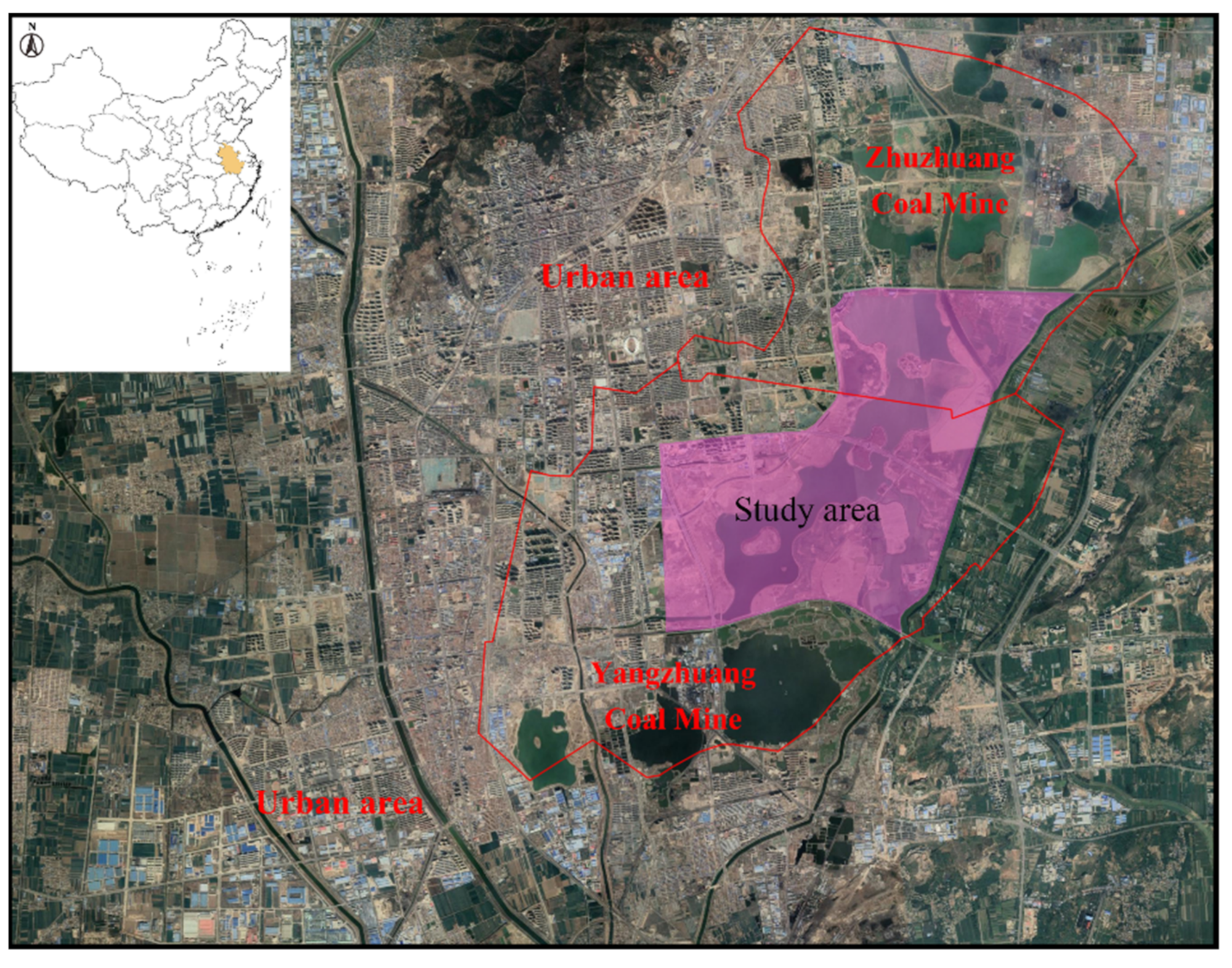

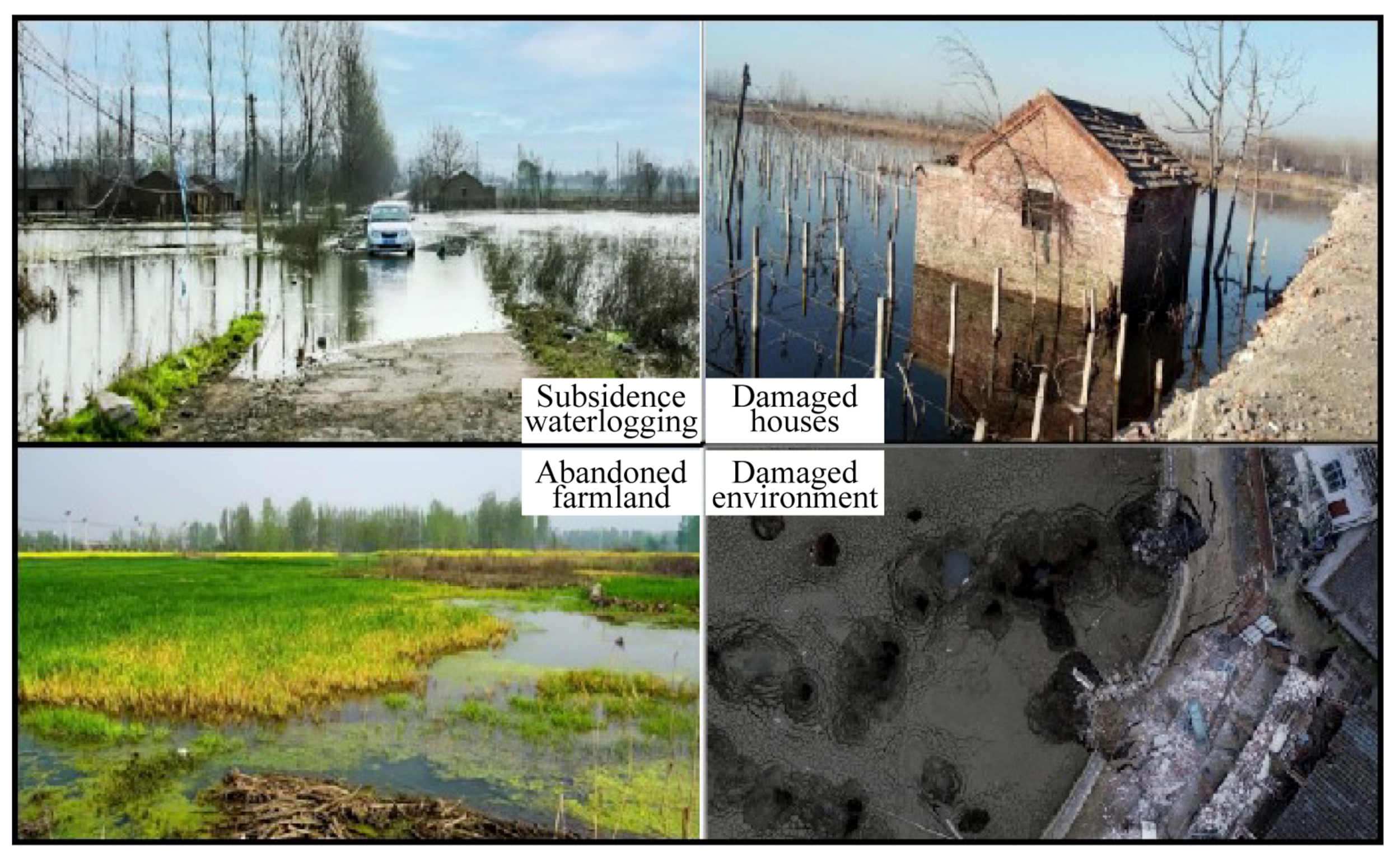



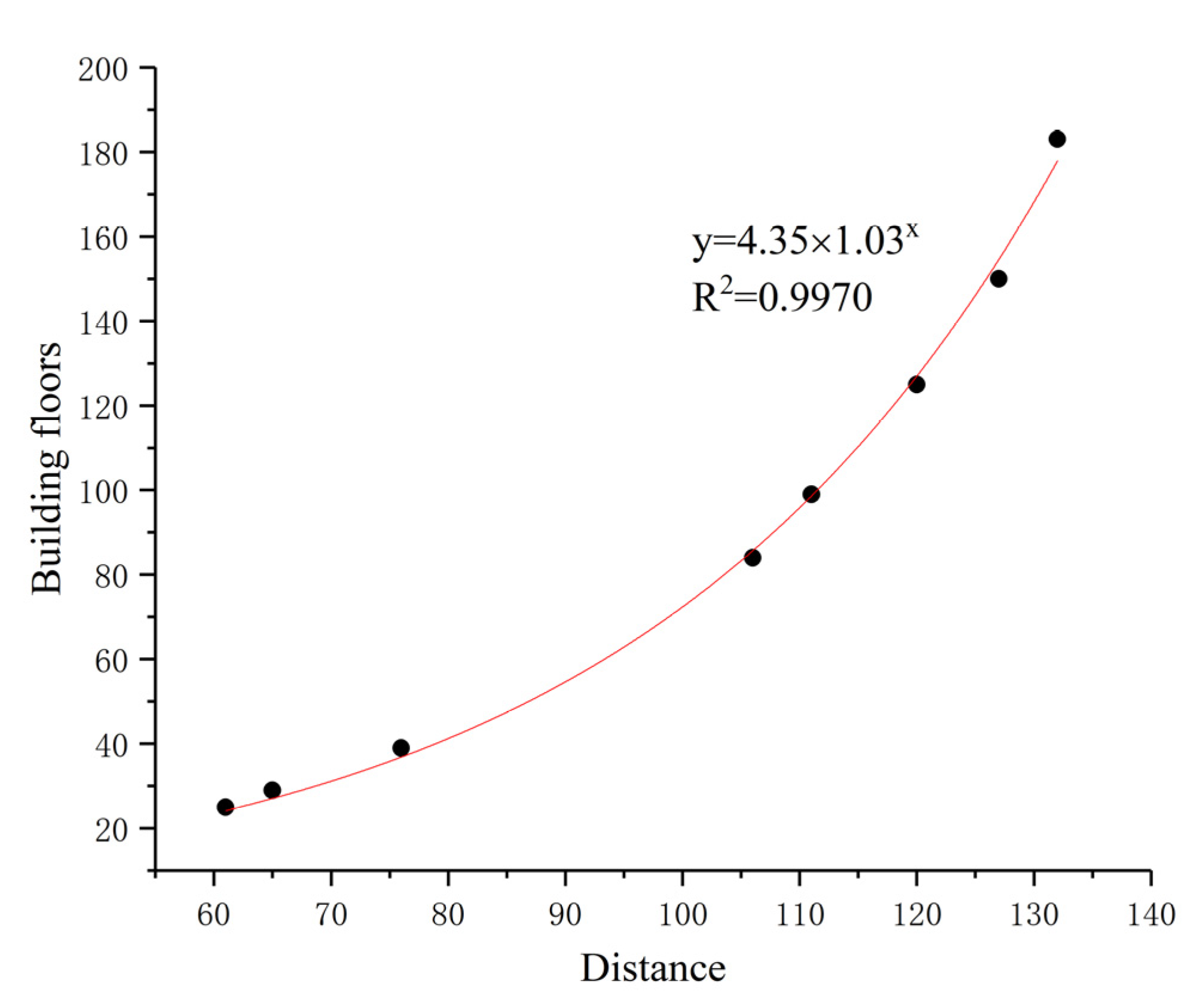
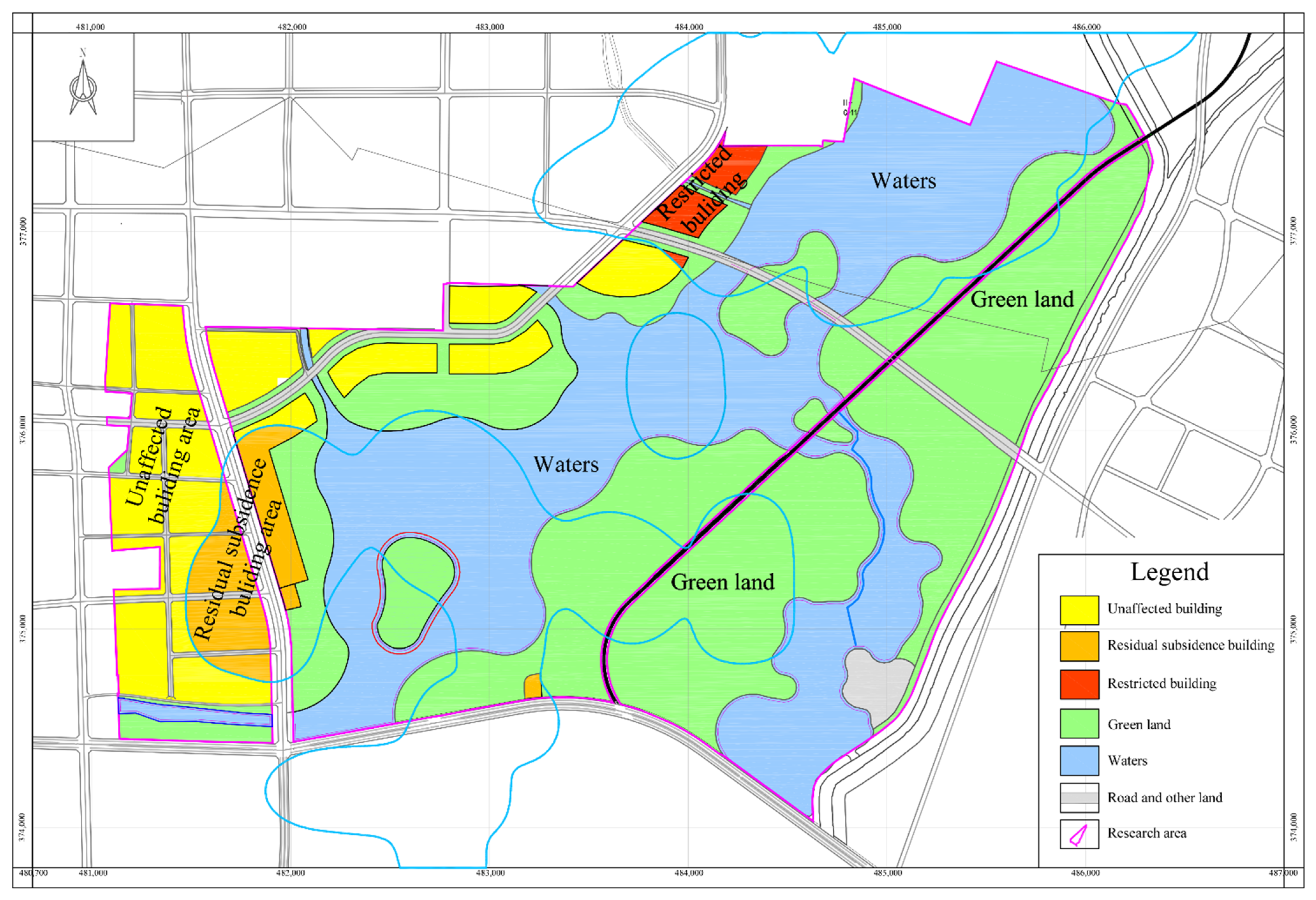
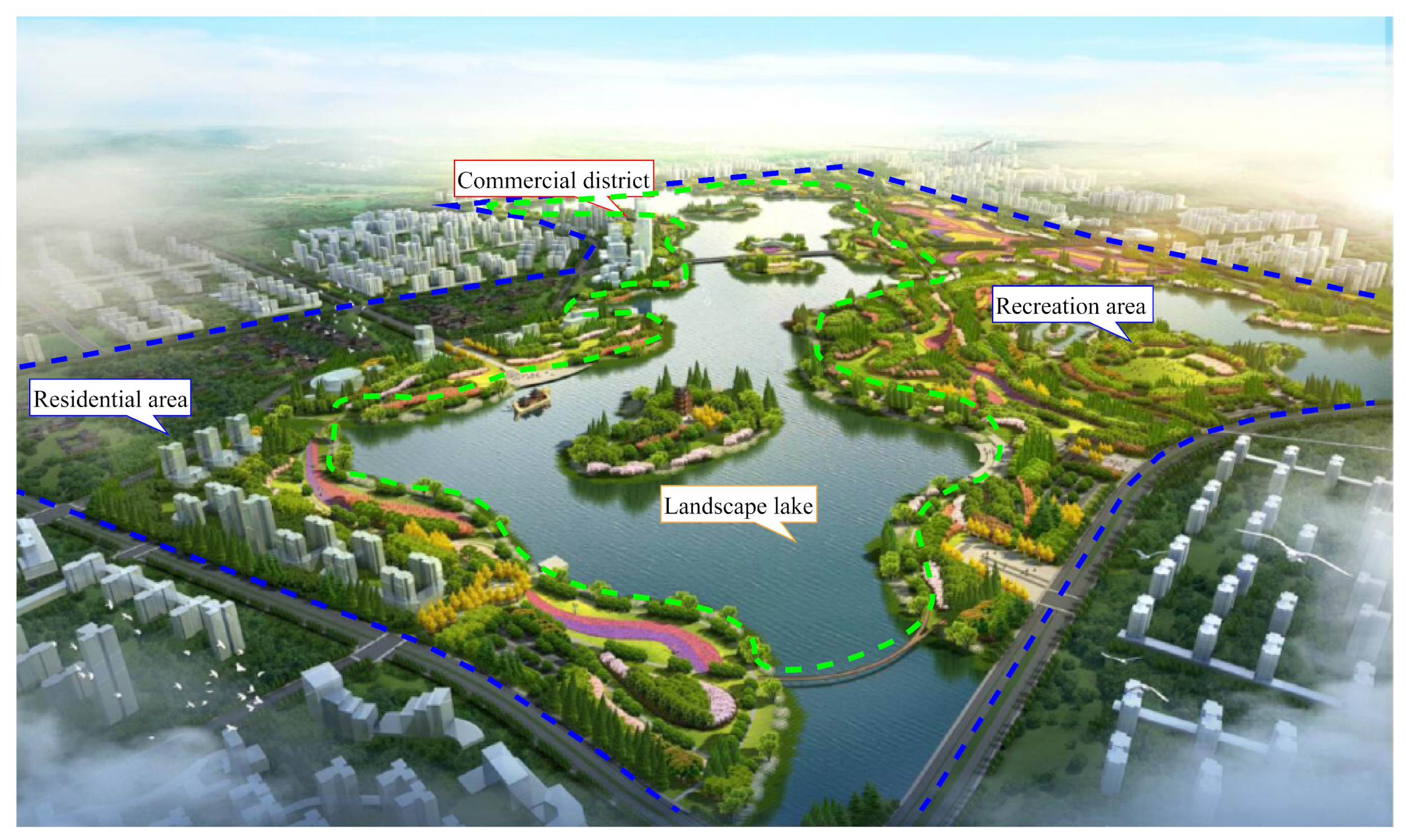

| Area | x Range of Coordinates | Design Elevation of Filling | |
|---|---|---|---|
| I | −r − s1 < x < −b/k | l + b/k < x < l + s2 + r | H0 + W(x) |
| II | −b/k < x < x0 | L − x0 < x < l + b/k | H0 + W(x) − H2(x) |
| III | x0 < x < (Wmax − b)/k | L − (Wmax − b)/k < x < l − x0 | H0 + W(x) − H2(x) |
| IV | (Wmax − b)/k < x < l/2 | L/2 < x < l − (Wmax − b)/k | H0 + W(x) − Wmax |
| Prediction Parameters | Subsidence q/m | Tangent of Major Influence Angle tanβ | Deviation of Influence Point S/m | Propagation Angle s/° | Displacement Factor b |
|---|---|---|---|---|---|
| Subsidence | 1.18 | 1.6 | 0 | 86 | 0.36 |
| Residual subsidence | 0.056 | 1.6 | 0 | 86 | 0.36 |
| Subsidence (mm) | Inclination (mm/m) | Curvature (mm/m2) | Horizontal Movement (mm) | Horizontal Deformation (mm/m) |
|---|---|---|---|---|
| 364 | 1.3 | 0.01 | 93 | −0.9,0.6 |
| Coal Seam | The Fourth | The Fifth | The Sixth |
|---|---|---|---|
| Hk (m) | 10.06 | 12.65 | 11.26 |
| Hl (m) | 40.79 | 49.50 | 44.64 |
| Hk + Hl (m) | 50.85 | 62.15 | 55.90 |
| Name | The Distance from Surface to Collapsed Zone and Cracked Zone/m | Building Floors |
|---|---|---|
| III4420 | 132 | 183 |
| III4418 | 127 | 150 |
| III4416 | 120 | 125 |
| III4417 | 111 | 99 |
| III4415 | 106 | 84 |
| III4423 | 76 | 39 |
| III428 | 65 | 29 |
| III426 | 61 | 25 |
| Type | Benefits |
|---|---|
| Economy | It provides 1634 hectares of usable land and 774 hectares of usable water areas. The utilization rate of water and land resources reached 100%. The revenue exceeded 30 billion yuan. |
| Ecology | The structure and function of the regional ecosystem have changed significantly. They have many functions, such as water supply, conditioning, biodiversity conservation and leisure. |
| Society | A total of 498 villages affected by coal mining subsidence have been relocated, and more than 2 × 105 people have been successfully resettled, easing human–land conflicts. |
Publisher’s Note: MDPI stays neutral with regard to jurisdictional claims in published maps and institutional affiliations. |
© 2022 by the authors. Licensee MDPI, Basel, Switzerland. This article is an open access article distributed under the terms and conditions of the Creative Commons Attribution (CC BY) license (https://creativecommons.org/licenses/by/4.0/).
Share and Cite
Zhu, X.; Zha, F.; Cheng, H.; Zheng, L.; Liu, H.; Huang, W.; Yan, Y.; Dai, L.; Fang, S.; Yang, X. Spatial Pattern Reconstruction of Water and Land Resources in Coal Mining Subsidence Areas within Urban Regions. Sustainability 2022, 14, 11397. https://doi.org/10.3390/su141811397
Zhu X, Zha F, Cheng H, Zheng L, Liu H, Huang W, Yan Y, Dai L, Fang S, Yang X. Spatial Pattern Reconstruction of Water and Land Resources in Coal Mining Subsidence Areas within Urban Regions. Sustainability. 2022; 14(18):11397. https://doi.org/10.3390/su141811397
Chicago/Turabian StyleZhu, Xiaojun, Feng Zha, Hua Cheng, Liugen Zheng, Hui Liu, Wenshan Huang, Yu Yan, Liangjun Dai, Shenzhu Fang, and Xiaoyu Yang. 2022. "Spatial Pattern Reconstruction of Water and Land Resources in Coal Mining Subsidence Areas within Urban Regions" Sustainability 14, no. 18: 11397. https://doi.org/10.3390/su141811397
APA StyleZhu, X., Zha, F., Cheng, H., Zheng, L., Liu, H., Huang, W., Yan, Y., Dai, L., Fang, S., & Yang, X. (2022). Spatial Pattern Reconstruction of Water and Land Resources in Coal Mining Subsidence Areas within Urban Regions. Sustainability, 14(18), 11397. https://doi.org/10.3390/su141811397










